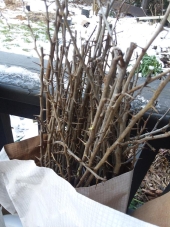posted 7 years ago
I have some questions and comments, might as well put them here. The subject seems appropriate.
As far as wind goes, the USDA has some documents out saying that osage-orange had been used for shelterbelts, so it has some ability to handle wind. Sort of by definition (horse high, bull strong, pig tight), it will form a fairly good windbreak from ground level to about the height of the hedge. It may be that windier locations cause it to not grow as tall as less windy locations.
Some article on the Internet, suggest that osage-orange is a pioneer species. It certainly is a species that was used by pioneers.
As a pioneer species, it would be expected to be somewhat to very intolerant of shade. Ignoring the very special circumstance of starting a hedge from scratch (all the trees are at the same height), on occasions sections of osage-orange hedge has been cut down. How could the hedge ever be repaired or replaced, if it is shade intolerant? I suppose other circumstances might be if lightning struck the hedge, or if fire burned part of a hedge.
I gather the hardest part of osage-orange as a hedge, was maintenance. There are people who apparently wove branches together similar to many hedges in the UK, but I wonder how many people did that?
As a an established tree, osage-orange could be reasonably expected to attain 1 foot thick trunk. I have read about tree to tree spacings as small as 9 inches. But, another way to start hedge was to dig a trench, and then pour into the trench a stream of liquid made by mushing hedge apples over winter in ice, and then processing a bit in spring time. Which would tend to place seeds closer than 9 inches. Supposedly they could be thinned out. But at a 9 inch (or even 12 inch) spacing, you are sort of saying that the hedge is effectively solid wood at ground level. The presence of more branches near ground level would hardly be needed.
If someone established a hedge at say 2 foot spacing, then yes having more branches at ground level would be helpful. But, if the hedge survived to be 4 or 5 years old, it might be just as effective to coppice the hedge at that point, and your shoots would now have a spacing much closer than every 2 feet.
Apparently at some point, it was not unheard of (common?) for a plow to be run parallel to the hedge, to break roots heading perpendicular to the hedge (out into the field). This was to stop the hedge from getting thicker (taking over more land). When was this done? What depth?
I have heard of a circumstance where osage-orange had been interplanted with honey locust. As I understand honey locust, to cut the roots with a plow would be to initiate many shoots coming up. And I believe that regardless of whether the parent tree had thorns or not, these shoots from damaging the roots of honey locust would be thorny. Does something like that happen with osage-orange? Is the story about honey locust accurate?
As far as regular maintenance of an osage-orange hedge goes, pruning was one requirement, which was an awful task because of the thorns (I wonder how many times Martha Stewart has pruned her osage-orange trees?). But apparently, another requirement was to keep other species from growing into the hedge (hackberry?). Would it be necessary to remove honey locust (or black locust)? Or were there a set of species that could be allowed to "invade" an osage-orange hedge?







